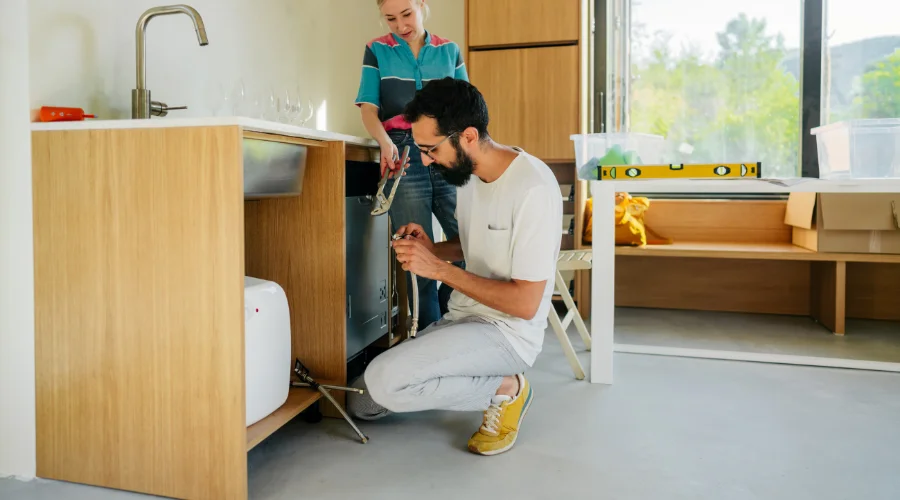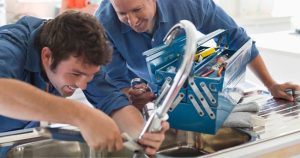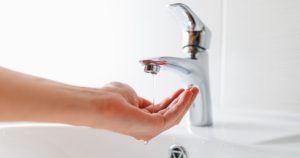Plumbing problems are inevitable, but you don’t always need a professional to handle them. With some knowledge and the right tools, you can tackle many issues independently and save time and money.
Key Takeaways
- Common Plumbing Issues: Leaky faucets, clogged drains, and running toilets can be fixed with basic tools and techniques.
- DIY Troubleshooting: Proper identification of issues and step-by-step repairs can resolve many problems effectively.
- Safety Precautions: Always turn off the water supply before repairs and know your limits to avoid exacerbating the problem.
- When to Call Professionals: For major issues like burst pipes or sewer backups, seek expert help.
Examples of Common Plumbing Issues
Leaky Faucets
A constant drip is more than an annoyance. It wastes water and increases utility bills. The usual culprits include worn-out washers or damaged O-rings. By replacing these components, you’ll save water and money while conserving resources.
Clogged Drains
Clogs happen due to hair, soap scum, grease, or food debris. Bathrooms often suffer from hair blockages, while kitchen sinks face grease buildup. Use a plunger, drain snake, or a mixture of baking soda and vinegar, followed by hot water to clear clogs. Regular maintenance prevents future blockages.
Running Toilets
A running toilet wastes water and money. It’s usually caused by a faulty flapper or improperly adjusted float. Replacing these components or changing the float can resolve the issue and restore regular flushing.
Low Water Pressure
Mineral buildup in aerators, hidden leaks, or supply line issues can reduce water pressure. To maintain consistent pressure, clean aerators with vinegar, check for leaks and perform routine inspections.
Burst Pipes
Freezing temperatures or wear and tear can cause pipes to burst, leading to severe water damage. Shut off the main water supply immediately, apply epoxy for temporary fixes, and call a professional for lasting solutions.
Identifying the Problem
Adequate DIY plumbing starts with proper identification. Inspect the affected area for:
- Leaks: Look for water stains, drips, or pooling water.
- Blockages: Slow drainage or unusual sounds often indicate clogs.
- Visual Clues: Rusty pipes or mineral deposits signal wear or buildup.
By pinpointing the issue, you’ll know whether it’s within your DIY capabilities or requires professional assistance.
DIY Troubleshooting & Guide to Common Plumbing Problems
1. Leaky Faucet
- Turn off the water supply.
- Disassemble the faucet and replace worn-out washers or O-rings.
- Reassemble the faucet and test for leaks.
2. Clogged Drain
- Use a plunger to create suction and remove blockages.
- For stubborn clogs, pour baking soda and vinegar into the drain, wait 30 minutes, and flush with hot water.
3. Running Toilet
- Inspect the toilet tank.
- Adjust the float or replace the flapper if necessary.
- Ensure the fill valve is working correctly.
4. Low Water Pressure
- Clean mineral deposits from the aerator using vinegar.
- Check for hidden leaks in pipes and connections.
5. Burst Pipes
- Shut off the water supply immediately.
- Apply epoxy to small leaks for temporary fixes.
- Call a plumber for significant repairs.
6. Water Heater Issues
- Check thermostat settings.
- Flush the tank to remove sediment buildup.
- Inspect connections for leaks and replace faulty components.
7. Frozen Pipes
- Use a hairdryer or hot towels to thaw pipes.
- Insulate pipes to prevent future freezing.
8. Dripping Showerhead
- Shut off the water supply.
- Clean mineral deposits from the Showerhead.
- Replace the washer if needed.
9. Garbage Disposal Jam
- Turn off the disposal and unplug it.
- Use a hex key to turn the disposal and clear jams manually.
10. Sump Pump Failure
- Check the power source.
- Clean the pump and pit of debris.
- Test the pump by filling the pit with water.
11. Toilet Seat Replacement
- Turn off the water supply and empty the tank.
- Remove the old seat and attach a new one securely.
12. Smelly Drains
- Pour baking soda and vinegar into the drain, then flush with hot water.
- Regular cleaning prevents odors.
13. Faulty Washing Machine Hoses
- Inspect hoses for cracks or bulges.
- Replace worn-out hoses with reinforced ones.
14. Shutoff Valve Issues
- Lubricate valves annually and replace them if they’re difficult to turn or leak.
15. Backed-Up Sewer Line
- Avoid flushing non-biodegradable items.
- Use a sewer auger or call a professional for severe clogs.
Safety Precautions
- Always turn off the water supply before repairs.
- Wear safety gear like gloves and goggles.
- Use tools cautiously, especially in confined spaces.
- Avoid complex repairs without proper knowledge.
If unsure, consult online tutorials or hire a licensed plumber to avoid worsening the problem.
When to Call a Professional
Some problems require expertise and specialized tools. Contact a professional plumber for:
- Major pipe leaks or bursts.
- Extensive water damage.
- Persistent low water pressure.
- Sewer line backups.
Hiring a licensed plumber ensures the issue is resolved safely and effectively.
FAQs About DIY Plumbing
1. Can I fix a leaky faucet myself?
Yes, replacing worn-out washers or O-rings can fix most leaky faucets. Essential tools like a wrench and screwdriver are usually sufficient.
2. What should I do if my drain is clogged?
Start with a plunger or a mixture of baking soda and vinegar. If the clog persists, use a drain snake or contact a plumber.
3. How can I prevent plumbing issues?
Regular maintenance, such as cleaning drains, inspecting pipes for leaks, and replacing old fixtures, can prevent common problems.
4. Is it safe to use chemical drain cleaners?
Chemical cleaners can damage pipes over time. Opt for natural alternatives like baking soda and vinegar.
5. How do I find hidden leaks?
Look for water stains, mold growth, or an unexplained increase in your water bill. Professional plumbers can use specialized tools to detect leaks.
6. What tools should I have for DIY plumbing?
Essential tools include a plunger, wrench, pipe tape, drain snake, and screwdriver.
7. When should I not attempt DIY plumbing?
Avoid DIY for problems like burst pipes, extensive water damage, or sewer backups. These require professional expertise.
Following these DIY plumbing tips, you’ll be better equipped to handle common issues and maintain a smoothly running home plumbing system. Always prioritize safety and know when to call in the experts for more complex problems.




